沪教版牛津英语2A二年上册教案全册
- 格式:docx
- 大小:263.75 KB
- 文档页数:77
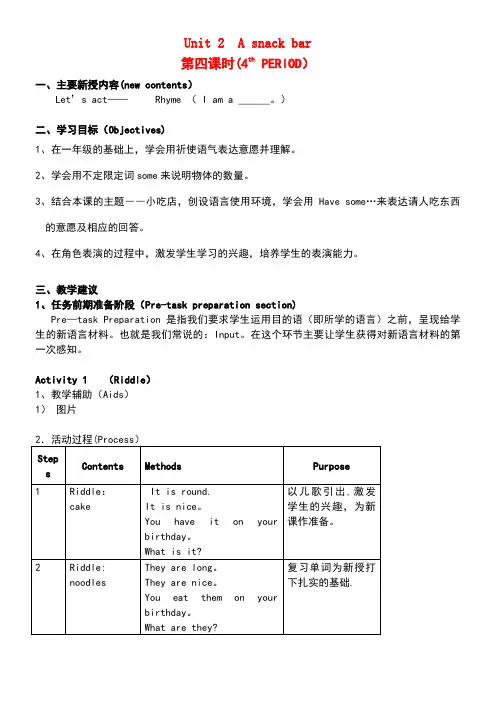
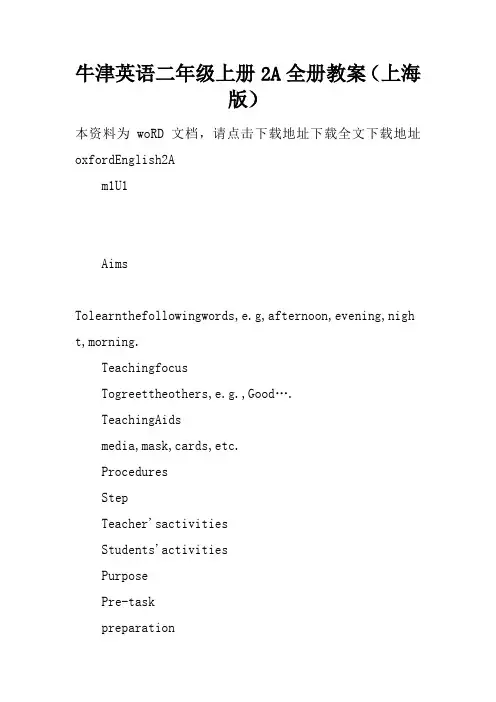
牛津英语二年级上册2A全册教案(上海版)本资料为woRD文档,请点击下载地址下载全文下载地址oxfordEnglish2Am1U1AimsTolearnthefollowingwords,e.g,afternoon,evening,nigh t,morning.TeachingfocusTogreettheothers,e.g.,Good….TeachingAidsmedia,mask,cards,etc.ProceduresStepTeacher'sactivitiesStudents'activitiesPurposePre-taskpreparation.Singasong.2.Sayarhyme..Singasong.2.Sayarhyme.利用歌曲,让学生进入学习状态。
while-taskprocedure.Toteach:afternoonToelicit:T:Goodafternoon,boysandgirls.Readtheword.T:Say“goodafternoon”toyourclassmatesorteachers. Showsomepictures2.Toteach:eveningShowapictureandask:Lookatthesun.Isitafternoon? Readtheword.Fillintheblanks:_veningGuess:morningorEvening?Say“Goodevening”tomrtiger,mrdog,…Letstudentdopair-work3.Toteach:nightT:Look,thesunismissing.whatdoyousee?ReadShowapictureRhyme:Night,night,goodnight,mum.Night,night,goodnight,Dad. Goodnight,goodnight,Hu----hu---makeanewrhyme. Showapictureofnight.T:It’snight.Goodnight,children. 4.Toteach:morningListentoacockReadEnjoyasong..Ss:Goodafternoon.2.Boysreadit.Girlsreadit.3.Say“Goodafternoon.”totheothers.4.Saytogether..Ss:No.2.choosetheanswer.3.Playaguessinggame.4.Role-playintheeveningshow5.workinpairs.1.S:Isee…2.Read3.Sayarhyme.4.makearhyme1.Ss:Goodnight.2.Followtheteacher3.Singorenjoythesong根据上课的实际时间,先教授afternoon一词.从情景过度到实际生活,学生从学到用。
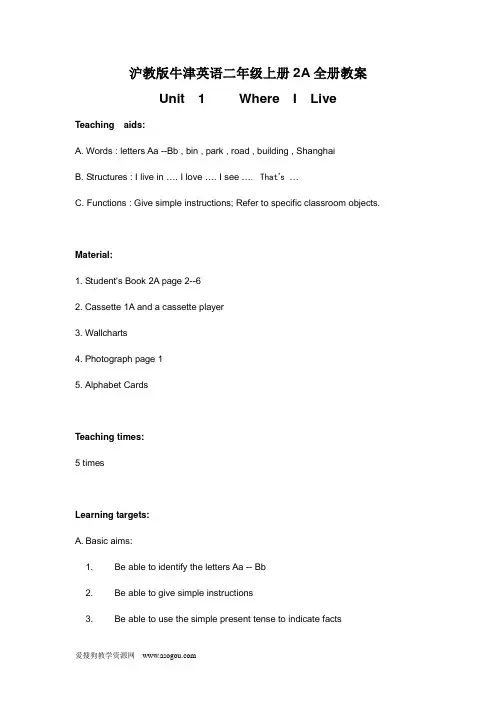
沪教版牛津英语二年级上册2A全册教案Unit 1 Where I Live Teaching aids:A. Words : letters Aa --Bb , bin , park , road , building , ShanghaiB. Structures : I live in …. I love …. I see …. That’s …C. Functions : Give simple instructions; Refer to specific classroom objects.Material:1. Student's Book 2A page 2--62. Cassette 1A and a cassette player3. Wallcharts4. Photograph page 15. Alphabet CardsTeaching times:5 timesLearning targets:A. Basic aims:1. Be able to identify the letters Aa -- Bb2. Be able to give simple instructions3. Be able to use the simple present tense to indicate facts4. Be able to "point to your home"5. Read the rhymeB. Further aims:1.2.Practise saying a new rhyme substituting 'Shanghai' with another places Language focus:1. Using the definite article to refer to specific classroom objects2. Using the simple present tense to express interests and preferences3. Learning the words: bin , park , road , building , ShanghaiPeriod 1Teaching focus:Using imperatives to give simple instructionsUsing the definite article to refer to specific classroom objectsTeaching steps:Period 2Teaching focus:Using the simple present tense to indicate factsUsing the simple present tense to express interests and preferences Teaching steps:Period 3Teaching focus:Using nouns to identify objectUsing proper nouns to refer to places Teaching steps:Period 4Teaching focus:Asking ' Wh-' questions to find out various kinds of specific information about a person Using the simple persent tense to express truthUsing the simple persent tense to express interests and preferencesTeaching steps:Period 5Teaching focus:Using the simple persent tense to express interests and preferences Teaching steps:Unit 4 Going about Teaching designing:Teaching aids:A.Words: letters Gg—Hh, plane, ferry, train, taxi, car, bus, van.B.Structures: Get ……How do you go to……C.Functions: Give simple instructions; Using connectives to add information Material:1.Student’s Book 2A page 17-212.Cassette 1A and a cassette player3.Wall charts4.Photograph page 145.Alphabet CardsTeaching times:5 timesLearning targets:A.Basic aims:1.Be able to identify the letters Gg--Hh2.Be able to give simple instructions3.Be able to introduce oneself using I’m.4.Be able to write the sentence Hello, I’m <name>.5.Sing a song.B.F urther aims:ing more information to introduce oneself2.The sorts of the alphabetLanguage focus:ing imperatives to give simple instructions2.Asking How questions to find out means and Using prepositions to indicatemeas3.Learning the words: plane……Period 1Teaching focus:Using imperative to give simple instructions Teaching steps:Period 2Teaching focus:Asking How questions to find out mean Using prepositions to indicate means Using formulaic expressions to take leave Teaching steps:Period 3Teaching focus:Using nouns to identify forms of transport. Teaching steps:Period 4Teaching focus:Using formulaic expressions to indicate how people travel Teaching steps:。
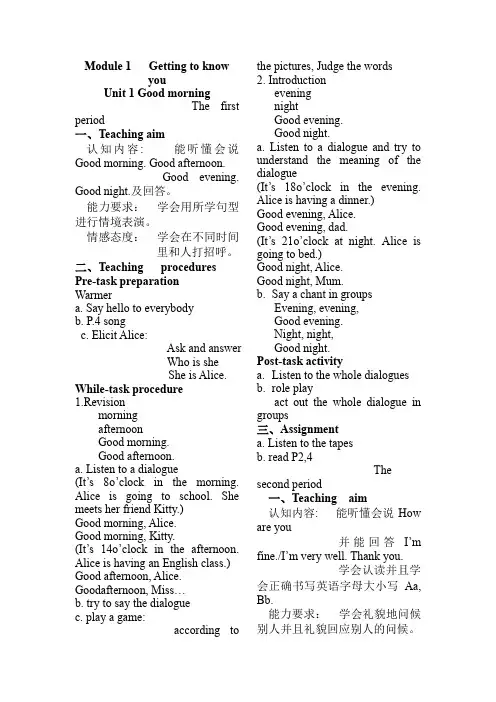
Module 1 Getting to knowyouUnit 1 Good morningThe first period一、Teaching aim认知内容: 能听懂会说Good morning. Good afternoon.Good evening. Good night.及回答。
能力要求:学会用所学句型进行情境表演。
情感态度:学会在不同时间里和人打招呼。
二、Teaching procedures Pre-task preparationWarmera. Say hello to everybodyb. P.4 songc. Elicit Alice:She is Alice. While-task procedure1.RevisionmorningafternoonGood morning.Good afternoon.a. Listen to a dialogue(It’s 8o’clock in the morning. Alice is going to school. She meets her friend Kitty.)Good morning, Alice.Good morning, Kitty.(It’s 14o’clock in the afternoon. Alice is having an English class.) Good afternoon, Alice. Goodafternoon, Miss…b. try to say the dialoguec. play a game:according to the pictures, Judge the words2. IntroductioneveningnightGood evening.Good night.a. Listen to a dialogue and try to understand the meaning of the dialogue(It’s 18o’clock in the evening. Alice is having a dinner.)Good evening, Alice.Good evening, dad.(It’s 21o’clock at night. Alice is going to bed.)Good night, Alice.Good night, Mum.b.Say a chant in groupsEvening, evening,Good evening.Night, night,Good night.Post-task activitya.Listen to the whole dialoguesb.role playact out the whole dialogue in groups三、Assignmenta. Listen to the tapesb. read P2,4The second period一、Teaching aim认知内容: 能听懂会说How are you并能回答I’m fine./I’m very well. Thank you.学会认读并且学会正确书写英语字母大小写Aa, Bb.能力要求:学会礼貌地问候别人并且礼貌回应别人的问候。
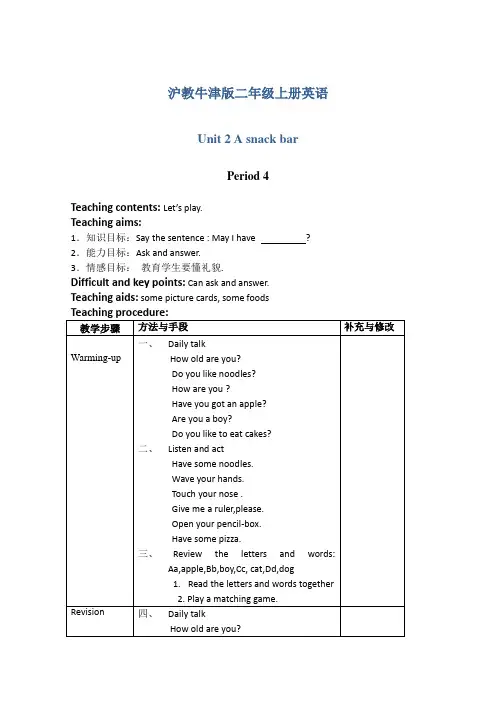
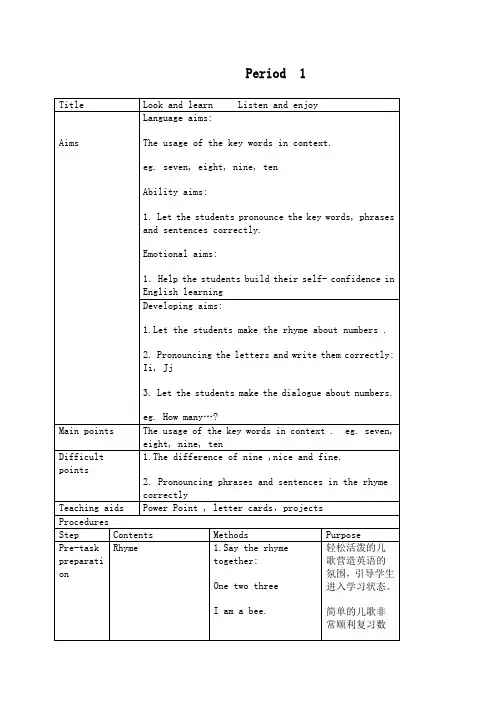
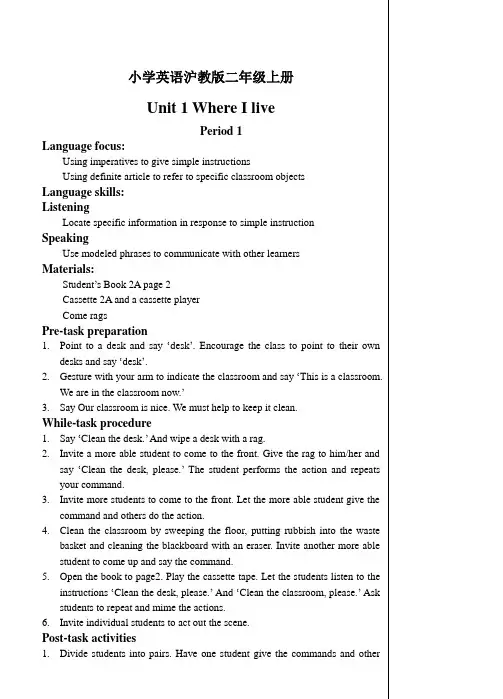
小学英语沪教版二年级上册Unit 1 Where I livePeriod 1Language focus:Using imperatives to give simple instructionsUsing definite article to refer to specific classroom objectsLanguage skills:ListeningLocate specific information in response to simple instructionSpeakingUse modeled phrases to communicate with other learnersMaterials:Student’s Book 2A page 2Cassette 2A and a cassette playerCome ragsPre-task preparation1.Point to a desk and say ‘desk’. Encourage the class to point to their owndesks and say ‘desk’.2.Gesture with your arm to indicate the classroom and say ‘This is a classroom.We are in the classroom now.’3.Say Our classroom is nice. We must help to keep it clean.While-task procedure1.Say ‘Clean the desk.’ And wipe a desk with a rag.2.Invite a more able student to come to the front. Give the rag to him/her andsay ‘Clean the desk, please.’The student performs the action and repeats your command.3.Invite more students to come to the front. Let the more able student give thecommand and others do the action.4.Clean the classroom by sweeping the floor, putting rubbish into the wastebasket and cleaning the blackboard with an eraser. Invite another more able student to come up and say the command.5.Open the book to page2. Play the cassette tape. Let the students listen to theinstructions ‘Clean the desk, please.’ And ‘Clean the classroom, please.’ Ask students to repeat and mime the actions.6.Invite individual students to act out the scene.Post-task activities1.Divide students into pairs. Have one student give the commands and othermime the actions. Then let them change roles.2.Invite pairs of students to act out the dialogue to the class. Students vote forthe best pairs.Period 2Language focus:Using the simple present tense to indicate factsUsing the simple present tense to express interests and preferencesUsing proper nouns to indicate placesLanguage skill:SpeakingUse modeled phrases to communicate with other learnersMaterials:Student’s Book 2A page 3Cassette 2A and a cassette playerWallcharts 2AA picture of Shanghai, a stamped envelope, a toy bearWorkbook 2A page 2Pre-task preparationAsk the students Where do you all live?Show a picture of Shanghai. Say That’s right, we all live in Shanghai. Shanghai is our home.While-task procedure1.Put up the wallchart for page 3. Tell a story something like this:Sam and his father went for a walk on Sunday. After a while they sat down to rest and watched the ferries to by. They could see the Oriental Pearl Tower and o lot of tall buildings. Can you recognize any? Sitting on the bench next to them were some tourists. The boy asked Sam where he lived and Sam replied ‘I live in Shanghai’. Sam was pleased. Children, do you love Shanghai? If you do, you must help to keep it clean. Do not litter. Throw all rubbish into the bin. Can you find a bin in this picture? Point to it.2.Ask questions such as the following:Where does Sam live?Where do you live?Does Sam love Shanghai?Do you love Shanghai?What is this?3.Hold up a stamped envelope and say My friend in Canada sent this to me.She had to write ‘Shanghai’ on it because I live in Shanghai. Say ‘I live in Shanghai’. And ask students to copy you.4.Hug a toy bear and say This is my bear. Her name is Sally. I love Sally. Hugthe bear more tightly and say “I love Sally.’ Show the picture of Shanghai again. Hug it and say ‘I love Shanghai.’Repeat. Get students to say after you.5.Open the book to page 3. play the cassette tape to let students hear thecorrect pronunciation of the words and sentences. Then ask individual students to say ‘I live in Shanghai.’ And ‘I love Shanghai.’Post-task activities1.Give each student a sheet of white drawing paper. Ask them to draw apicture of the place they live.2.Ask students to say something about their pictures by using the sentences ‘Ilive in …, I love…’ConsolidationWorkbook page 2:look, listen and repeat the correct sentence.Listen and draw.Period 3Language focus:Using nouns to identify objectsUsing proper nouns to refer to placesLanguage skills:SpeakingPronounce words properlyLearn the names and sounds of the letters ‘Aa,Bb’Materials:Student’s Book 2A page 4Cassette 2A and a cassette playerWallcharts 2AWorkbook 2A page 3Pre-task preparationPut up the wallchart for page 3. Ask the students to say something about the picture by using the sentences they have learned in the previous lesson: ‘I live in…’ and ‘I love…’While-task procedure1.Still referring to the wallchar, discuss what you can see in the picture.Introduce the word ‘building’. Hold up the picture card for ‘building’and say ‘building’. Ask students to repeat.2.Ask What things to you sometimes see lying on the pavement? Showexamples of rubbish that people throw away soft drink cans, plastic bags, food wrappers, etc. Ask How do they get there? Does it make Shanghai look beautiful? What should we always do with our rubbish? Show a toy bin and say ‘bin’ slowly. Ask students to repeat.3.Show the pictures of a park and a road. Ask Do you often go to the park? Toelicit the new words ‘park’ and ‘road’. Say the words slowly. Ask students to repeat.4.Put up the picture and word cards on the board in random order. Thenrearrange them by putting the word cards below their corresponding picture cards, as shown in their Student’s Books. Read the words with the students.5.Open the book to page 4. Play the cassette tape. Students listen and repeat.Ask students to point to each picture as the word is being read out.6.Show students the picture cards for ‘apple’and say Apple begins with thesound ‘a’. Show the word card for ‘apple’ and say ‘A… apple’. Repeat. Post-task activitySay something about the wallchart, using the new words students have just learnedConsolidationWorkbook page 3:A.Colour the word in the puzzle.B.Trace the lettersPeriod 4Language focus:Asking ‘wh-’ questions to find out various kinds of specific information about a personUsing the simple present tense to express truthLanguage skills:Use modeled phrases to communicate with other learnersOpen an interaction by eliciting a responseMaintain an interaction by providing informationMaterials:Student’s Book 2A page 5Cassette 2A and a cassette playerA big map of ChinaPre-task preparationSay yesterday we learned some new words. Do you remember what they are? Put up the picture cards for ‘bin’, ‘park’, ‘road’, ‘building’ and ‘Shanghai’. Hold up the word cards. Ask individual student to come up, take one, and put it under the corresponding picture. Continue until all cards have been matched. Then remove the pictures but leave the word cards. Ask various students to come up and get the word that you say.While-task procedure1.Put up a big map of China. Show students where Shanghai is.2.Ask ‘Where do you live?’. Encourage students to answer ‘I live inShanghai.’3.Play a ‘tourist game’ with the students. Invite a more able student to come tothe front.4.Get the students to open the book to page5. Play the cassette tape forstudents to listen to native speakers saying the lines while they look at the pictures in their own books.5.Divide students into groups of four. Have one student ask the question‘Where do you live?’ and other three answer it. Then let them change roles. 6.Invite groups of students to act out the dialogue to the class. ConsolidationWorkbook page 4: listen and draw the lines to find where they livePeriod 5Language focus:Using the simple present tense to express interests and preferences Language skills:ListeningIdentify key word in an utterance by recognizing stressSpeakingPronounce correctly words in connected speech by linking together and using appropriate stressMaterialsCassette 2A and a cassette playerA toy binPre-task preparation1.Flash the picture cards and word cards for ‘bin’, ‘building’, ‘park’, ‘road’and ‘Shanghai’ to check that students remember the words.2.Ask various students to point to each picture and say ‘This is …’.While-task procedure1.i nvite some students to clean the classroom with you. Put rubbish into a toybin you have brought to class. Say We use the bin every day. We keep Shanghai clean every day.2.Get students to open the Students’ book page 6. Discuss with students whereSam and May live and what they are doing now.3.Invite two students to be Sam and May putting rubbish into the bin.4.Read the rhyme slowly line by line. Practise saying both verses.5.Explain the words and phrases ‘use’, ‘every day’and ‘keep it clean’instudent’s mother tongue.6.Play the cassette for the rhyme. Students follow and read the rhyme.7.Invite pairs of students to act out the rhyme to the class.Post-task activityHave pairs of students practise saying a new rhyme substituting ‘Shanghai’with ‘Beijing’ or ‘Guangzhou’. Invite pairs to say their rhymes to the class.。
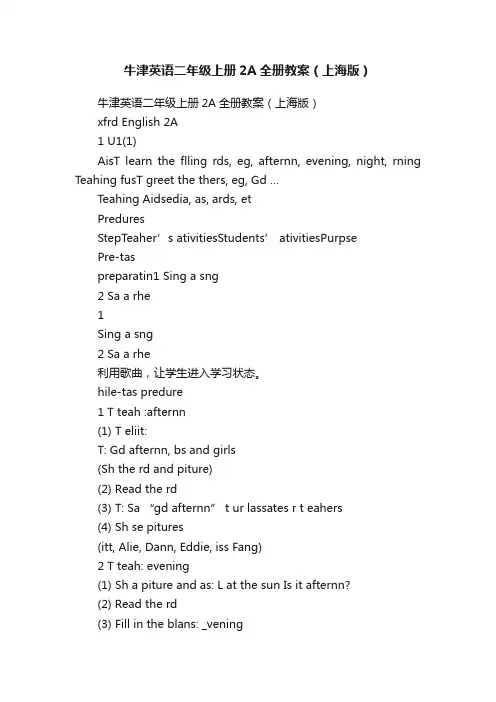
牛津英语二年级上册2A全册教案(上海版)牛津英语二年级上册2A全册教案(上海版)xfrd English 2A1 U1(1)AisT learn the flling rds, eg, afternn, evening, night, rning Teahing fusT greet the thers, eg, Gd …Teahing Aidsedia, as, ards, etPreduresStepTeaher’s ativitiesStudents’ ativitiesPurpsePre-taspreparatin1 Sing a sng2 Sa a rhe1Sing a sng2 Sa a rhe利用歌曲,让学生进入学习状态。
hile-tas predure1 T teah :afternn(1) T eliit:T: Gd afternn, bs and girls(Sh the rd and piture)(2) Read the rd(3) T: Sa “gd afternn” t ur lassates r t eahers(4) Sh se pitures(itt, Alie, Dann, Eddie, iss Fang)2 T teah: evening(1) Sh a piture and as: L at the sun Is it afternn?(2) Read the rd(3) Fill in the blans: _vening(4) Guess: rning r Evening?() Sa “Gd evening” t r tiger, r dg, …(6)Let student d pair-r3 T teah: night(1) T: L, the sun is issing hat d u see?(2) Read(3) Sh a piture (a girl sas “Gd night” t her u and dad) Rhe: Night, night, gd night, uNight, night, gd night, DadGd night, gd night,Hu----hu---(4) ae a ne rhe() Sh a piture f nightT: It’s night Gd night, hildren4T teah: rning(1) Listen t a (sund)(2) Read(3) En a sng1 Ss: Gd afternn2 Bs read itGirls read it3 Sa “Gd afternn” t the thers4 Sa tgether(Gd afternn, …)1 Ss: N2 hse the anser3 Pla a guessing gae4 Rle-pla in the evening sh (anials’ass) r in pairs1 S: I see…2 Read3 Sa a rhe4 ae a rhe1 Ss: Gd night(En a sng: Gd night)2 Fll the teaher3 Sing r en the sng根据上的实际时间,先教授afternn一词从情景过度到实际生活,学生从学到用。
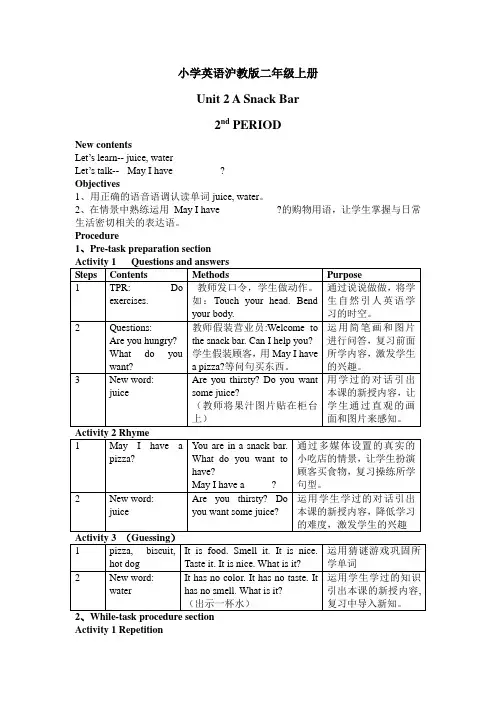
小学英语沪教版二年级上册Unit 2 A Snack Bar2nd PERIODNew contentsLet’s learn-- juice, waterLet’s talk-- May I have _________?Objectives1、用正确的语音语调认读单词juice, water。
2、在情景中熟练运用May I have ___________?的购物用语,让学生掌握与日常生活密切相关的表达语。
Procedure1、Pre-task preparation sectionActivity 1 Questions and answersSteps Contents Methods Purpose1 TPR: Doexercises.教师发口令,学生做动作。
如:Touch your head. Bendyour body.通过说说做做,将学生自然引人英语学习的时空。
2 Questions:Are you hungry?What do youwant? 教师假装营业员:Welcome tothe snack bar. Can I help you?学生假装顾客,用May I havea pizza?等问句买东西。
运用简笔画和图片进行问答,复习前面所学内容,激发学生的兴趣。
3 New word:juice Are you thirsty? Do you wantsome juice?(教师将果汁图片贴在柜台上)用学过的对话引出本课的新授内容,让学生通过直观的画面和图片来感知。
Activity 2 Rhyme1 May I have apizza? You are in a snack bar.What do you want tohave?May I have a _____?通过多媒体设置的真实的小吃店的情景,让学生扮演顾客买食物,复习操练所学句型。
2 New word:juice Are you thirsty? Doyou want some juice?运用学生学过的对话引出本课的新授内容,降低学习的难度,激发学生的兴趣Activity 3 (Guessing)1 pizza, biscuit,hot dog It is food. Smell it. It is nice.Taste it. It is nice. What is it?运用猜谜游戏巩固所学单词2 New word:water It has no color. It has no taste. Ithas no smell. What is it?(出示一杯水)运用学生学过的知识引出本课的新授内容,复习中导入新知。
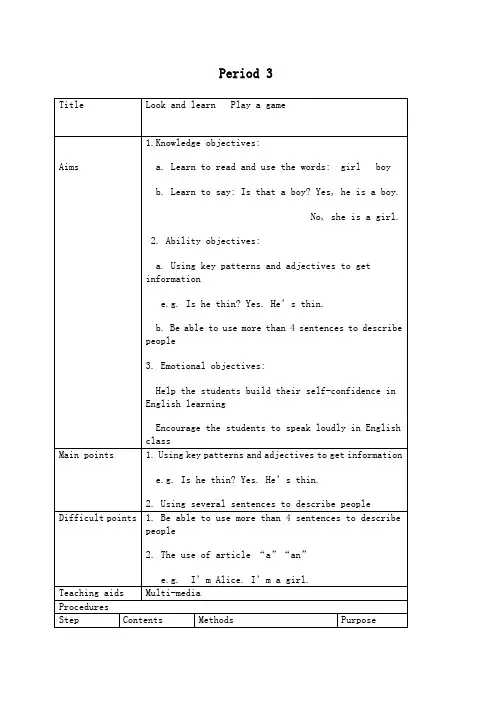
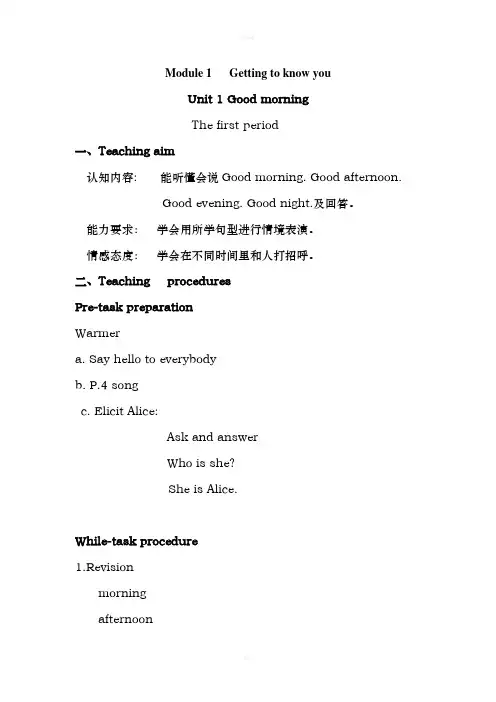
Module 1 Getting to know youUnit 1 Good morningThe first period一、Teaching aim认知内容: 能听懂会说Good morning. Good afternoon.Good evening. Good night.及回答。
能力要求:学会用所学句型进行情境表演。
情感态度:学会在不同时间里和人打招呼。
二、Teaching proceduresPre-task preparationWarmera. Say hello to everybodyb. P.4 songc. Elicit Alice:Ask and answerWho is she?She is Alice.While-task procedure1.RevisionmorningafternoonGood morning.Good afternoon.a. Listen to a dialogue(It’s 8o’clock in the morning. Alice is going to school. She meets her friend Kitty.)Good morning, Alice.Good morning, Kitty.(It’s 14o’clock in the afternoon. Alice is having an English class.)Good afternoon, Alice.Goodafternoon, Miss…b. try to say the dialoguec. play a game:according to the pictures, Judge the words2. IntroductioneveningnightGood evening.Good night.a. Listen to a dialogue and try to understand the meaning of the dialogue(It’s 18o’clock in the evening. Alice is having a dinner.) Good evening, Alice.Good evening, dad.(It’s 21o’clock at night. Alice is going to bed.)Good night, Alice.Good night, Mum.b.Say a chant in groupsEvening, evening,Good evening.Night, night,Good night.Post-task activitya.Listen to the whole dialoguesb.role playact out the whole dialogue in groups三、Assignmenta. Listen to the tapesb. read P2,4The second period一、Teaching aim认知内容: 能听懂会说How are you?并能回答I’m fine./I’m very well. Thank you.学会认读并且学会正确书写英语字母大小写Aa, Bb.能力要求:学会礼貌地问候别人并且礼貌回应别人的问候。
牛津小学英语2a教案教案标题:牛津小学英语2a教案教学目标:1. 学习掌握基本的英语词汇和句型。
2. 培养学生的听、说、读、写的综合能力。
3. 培养学生的合作和沟通能力。
教学准备:1. 教材:《牛津小学英语2A》2. 教具:黑板、彩色粉笔、教学PPT、音乐、图片、实物等。
教学过程:Step 1: Warm-up (热身活动) (10分钟)教师可以使用教学PPT或音乐等方式引导学生进行热身活动,如唱一首英文歌曲或说一些简单的英文口号,让学生活跃起来,进入英语学习的氛围。
Step 2: Presentation (呈现) (20分钟)1. 教师可以使用图片、实物等教具,呈现新学的词汇,如动物、水果、颜色等。
并引导学生进行观察和描述,帮助他们理解和记忆新词汇。
2. 教师可以使用教材上的图片和示例对话,引导学生学习新的句型和表达方式,并通过多次模仿和练习,帮助他们掌握。
Step 3: Practice (练习) (30分钟)1. 教师可以设计一些基础的听力练习,如听录音,找出正确的单词或图片等。
通过听力练习,培养学生的听力理解能力。
2. 教师可以设计一些口语练习,如小组活动,让学生两两组队进行对话练习,加强他们的口语表达和交流能力。
3. 教师可以设计一些阅读和写作练习,如让学生阅读课本中的短文,并回答相关问题;或让学生根据所学内容,写一篇小短文等。
Step 4: Consolidation (巩固) (20分钟)1. 教师可以使用教材上的练习题,让学生进行复习和巩固。
2. 教师可以设计一些游戏活动,如英语单词卡片游戏、角色扮演等,让学生在游戏中巩固所学的知识。
Step 5: Assessment (评估) (10分钟)教师可以设计一些简单的评估题目,检查学生对所学内容的理解和掌握程度。
可以使用选择题、填空题、配对题等形式。
Step 6: Wrap-up (总结) (10分钟)教师可以对本节课的学习内容进行总结,并鼓励学生积极参与下节课的学习。
第四课时(4th PERIOD)一、主要新授内容(new contents)Let’s talk: I am sorry. It’s OK.二、学习目标(Objectives)1、本课将学习致歉“I’m sorry.”It’s OK.”2、结合本单元的主题――夏天,创设语言使用环境,学习句型。
3、适当拓展单词swimming pool,应答句型:That’s all right.4、掌握字母Yy, yellow。
三、教学建议1、任务前期准备阶段(Pre-task preparation section)Pre-task Preparation是指我们要求学生运用目的语(即所学的语言)之前,呈现给学生的新语言材料。
也就是我们常说的:Input。
在这个环节可以是复习前面所学知识引出新知识,也可以让学生获得对新语言材料的第一次感知。
Activity 1 (Guessing)1、教学辅助(Aids)1)电脑(2B-U7-16)2.活动过程(Process)Steps Contents Methods Purpose1 Guessing game (出示一个拼图的一角)T:Look,this place is veryintreseting.Guess! What is it?P: Is this a park/zoo/beach?T: No,it is a swimming pool. 运用游戏吸引学生的注意,在猜谜过程中激发学生的积极思维,引出新课内容。
2 Repetition It is a swimming pool.(出现完整的游泳池画面)初步感知新授内容。
Activity 2 (story)1、教学辅助(Aids)1)电脑(2B-U7-17)2)屏幕2.活动过程(Process)Steps Contents Methods Purpose1 Questions andanswersDo you like to go to theswimming pool?What do you like to do in theswimming pool?巩固以前所学知识,激发学生思维,为新课作准备。
沪教牛津版二年级上册英语Unit 2 A snack barPeriod 1Teaching contents:Let’s act.Teaching aims:1.知识目标:学会招待客人吃东西的2句简单的祈使句.2.能力目标: 会用英语发命令并且根据命令做动作。
3.情感目标:要礼貌对人.Difficult and key point: Can order and act two sentences. Teaching aids:1.Some noodles and some soup2. A cassette player and cassett3.Some picture cards and word cardsPeriod 2Teaching contents: Let’s act.Teaching aims:1.知识目标:Learn the sentence :May I have a ?2.能力目标:Learn how to buy something in the shop.3.情感目标:教育学生要懂礼貌。
Difficult and key points: Say the sentence correctly.Teaching aids: 1. A big picture.2.Some foods.3.A cassette player and cassette.Period 3Teaching contents:1.Let’s learn.2.Letters and words.Teaching aims:1.知识目标:a.Learn some words : biscuit, juice, waterb.Learn two letters and two words: Cc, Dd ,cat,dog2.能力目标:Act short dialogues using the new words.3.情感目标:Don’t throw rubbish.Difficult and key points:1.Read the words correctly.2.Read and write the letters correctly.Teaching aids:1.Picture and word cards.2.Letters and picture cards.。
精选【三篇】沪教版二年级上册英语教案【导语】英语教案设计是改善课堂教学的一种更高层次的探索,是提高课堂教学质量和效率的一项必要工作,它可以促进教学的系统化,使老师掌握讲课节奏。
以下是无忧考网为您准备的与沪教版二年级上册英语教案相关的资料,希望可以帮助到您!【篇一】教学目标:teach tell a storylanguage重点难点:using modeled phrases to communicate with other learner.教学准备:tape recorder, word cards.teaching教学过程:pre-task preparation1. greetings:t: hello, boys and girls.ss: hello, teacher.t: how are you?ss: fine, thank you. and you?t: very well. thanks.2. warming up:sing the song, and review the words with gesture.……3. free talk:1.revise the words. i would put up the pictures, and let students say the words.2 .revise the letters from a-l.3.revise the pronunciation of the letters in the words. greetings in the class.say and do together.revise the letters 互相问候,创造英语气氛。
激跃课堂气氛。
复习以往知识。
while-taskprocedure1. open the student’s book to page 41. discuss with students what new clothes they need and what colour they like.2 .put up the wallchart for page 41. tell a story something like this:may’s birthing was near. she went shopping with her mum. she needed a new dress for her birthday party. may was looking through all the dresses on the rack when mum found a pretty green dress for her. but she didn’t like it. she liked pink dresses. at last shefound one herself. it was beautiful. she thanked mum for buying her the new dress she liked.3. tell the story in english by reading out the words in each speech bubble.4. play the cassette tape. students listen carefully and follow the sequence of the story. when they listen again, have them say the expressions with the tape.i need a new dress.i don’t like green.i like pink.….act the model dialogue for the class.tell the story in english by reading out the words in each speech bubble.performing the role-play通过教授歌曲来渲染一下气氛1.比较有趣味性,2.学生积极性提高,听录音再次纠正部分学生的错误发音。
Module 1 Getting to know youUnit 1 Good morningThe first period一、Teaching aim认知内容: 能听懂会说Good morning. Good afternoon. Good evening. Good night.及回答。
能力要求:学会用所学句型进行情境表演。
情感态度:学会在不同时间里和人打招呼。
二、Teaching proceduresPre-task preparationWarmera. Say hello to everybodyb. P.4 songc. Elicit Alice:Ask and answerWho is she?She is Alice.While-task procedure1.RevisionmorningafternoonGood morning.Good afternoon.a. Listen to a dialogue(It’s 8o’clock in the morning. Alice is going to school. She meets her friend Kitty.)Good morning, Alice.Good morning, Kitty.(It’s 14o’clock in the afternoon. Alice is having an English class.)Good afternoon, Alice.Goodafternoon, Miss…b. try to say the dialoguec. play a game:according to the pictures, Judge the words2. IntroductioneveningnightGood evening.Good night.a. Listen to a dialogue and try to understand the meaning of the dialogue(It’s 18o’clock in the evening. Alice is having a dinner.) Good evening, Alice.Good evening, dad.(It’s 21o’clock at night. Alice is going to bed.)Good night, Alice.Good night, Mum.b.Say a chant in groupsEvening, evening,Good evening.Night, night,Good night.Post-task activitya.Listen to the whole dialoguesb.role playact out the whole dialogue in groups三、Assignmenta. Listen to the tapesb. read P2,4The second period一、Teaching aim认知内容: 能听懂会说How are you?并能回答I’m fine./I’m very well. Thank you.学会认读并且学会正确书写英语字母大小写Aa, Bb.能力要求:学会礼貌地问候别人并且礼貌回应别人的问候。
情感态度:通过本课时的学习,培养师生之间礼貌问候并且进一步加深同学之间的友谊。
二、Teaching proceduresPre-task preparationWarm-upa. Greet the childrenHello./Hi./Good morning. /Good afternoon.b.P4songc.introduce 2 puppetsWhile-task procedure1.IntroductionHow are you?I’m fine. /I’m very well.a.Listen to a dialogue.Puppet1: Hello, I’m a little pig. Oink, oink.Puppet2: Hello, I’m a little dog. Woof. Woof.Puppet1: How are you?Puppet2: I’m very well. Thank you.b.Hold up a puppet and to learn’ I’m very well. Thank you.’A teacher asks, and has the students answer.c.Hold up another puppet and to learn ’How are you?’d.Act out the dialogue in pairs.Thank you.Try to say with good friends.2. Learn the lettersA aB ba.Learn to say the sound of the letter.(Hello, I’m the little pig’s friend. )What’s this?It’s A. It’s an apple.Look, ’A’ in an apple.A, a.An apple. An apple.b. learn the chantP.5in pairs.c. play a gameshow a letter card and ask students to say a word with the letter.d. learn how to write the letters.Revision: P3 Look and saya.Listen and repeatb.Act outPost-task activityListen to the tape and read P3,5三、AssignmentTalk with your classmates how to greet to people.Module1 Getting to know youUnit 3 I’m eightThe first period一、Teaching AIMS:1. To learn the new words: seven eight nine ten2. To learn the new sentences and extension: Seven, eight, nine, ten3. To learn how to describe things with numbers.4. To be able to use numbers around us.二、Teaching AIDS: cattle player, word cards ,三、teaching proceduresⅠ. Pre-task PreparationWarming-up1. Song: Ten little paper rabbits2. Rhyme:One, two, three.I am a bee.…2. RevisionThe numbers:One, two, three, four, five, sixQ:How many pencils?/rulers?/apples... Ps spell the wordsAsk and answer (T-Pn)Ⅱ. While-task Procedure1.ElicitationContent1: sevenT asks and ps answer1+2=__2+3=__6+1=__2.Mechanical Practicea.Ps follow Tb.Spell the wordContent 2:eight1.ElicitationHow old are you?T asks and pn answer2.Mechanical Practice Ps follow Tps spell3.Meaningful PracticeHello, ...Hello.How old are you?I’m …Content 3:nine, ten Ten minus nine is eight.1. Elicitation8+1=__9+1=__10-1=__10-9=__Ps fill in the blanks 2.Mechanical Practice Ps follow Tps spellWhen I am sad I sayWhen I am happy I say.3.Meaningful Practice4.5+4=__5.10-3=__6.7-0=__7.8-6=__Ⅲ. Post-task ActivityActivity 1One, two, three, touch your knees.Ps read after the tape四、Consolidation1.Listening: SB P102.Speaking SB P103.Reading SB P104.WritingWords: one two three four five six seven eight nine tenThe second period一.Teaching AIMS:1.To learn the new patterns and extension:You’re…Are you…?Yes, I’m…/No. I’m…Sorry.That’s OK.2. To learn how to use model phrases to communicate with other learner二、teaching AIDS:media, computer, pictures, word/sentence cards三、PROCEDURESⅠ. Pre-task Preparation1.Warming-up1. RhymeOne, two, three, touch your knees.2.RevisionI’m Jojo. I’m twenty-four. I’m a girl. I’m tall.How about you?Ⅱ. While-task ProcedureContent1:You are…Are you…?Yes, I’m…/No. I’m…1.ElicitationElicit by previous practice2.Mechanical PracticePs say/Bs say/Gs say3.Meaningful PracticeGuessing gameI’m ten years old. I like to swim. And I can swim fast. I like to ride the bicycle, too.Content 2:Sorry.That’s OK.1.Elicitation1and 2 on P112.Mechanical PracticePs follow TBs say/Gs say3.Meaningful PracticeDialogue on P11Ⅲ. Post-task ActivityActivity 1P11-12 Ps read after the tapeActivity 2 Dialogue on P12Pg say and act四、ConsolidationListening: P11-P13Speaking: P11-P13Reading : P11-P13Writing: words:Sentence:Pic2 , 4(P11) Pic1(P12)Module 2 My family friends and meUnit 4 Can you swim?The first period一、Teaching aims认知内容: 能听懂会说run write swim fly这四个单词。